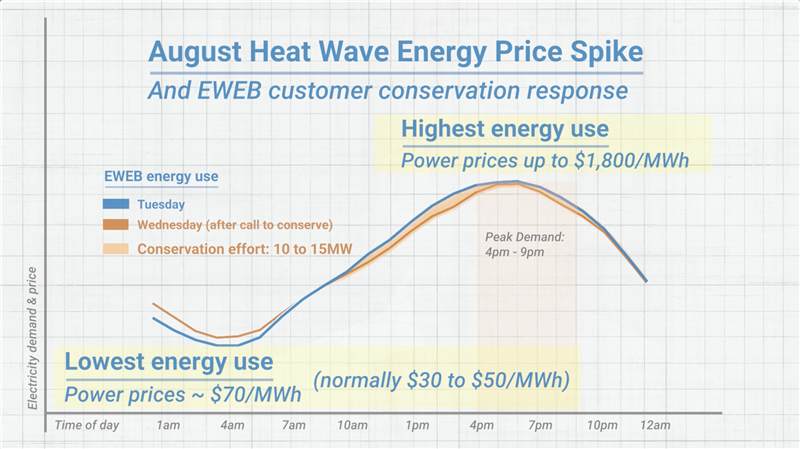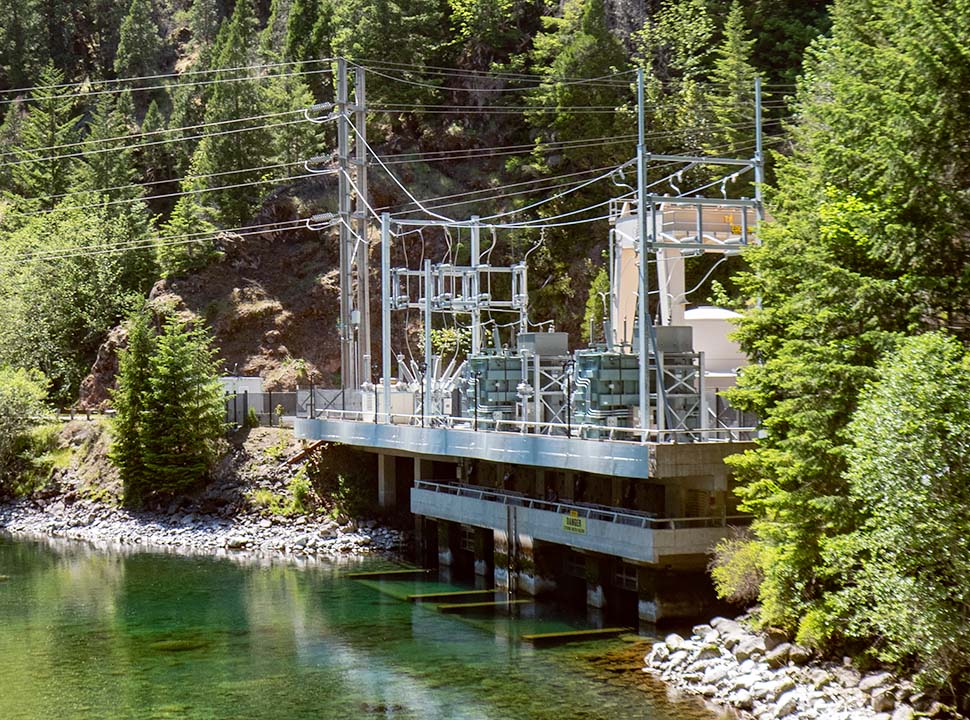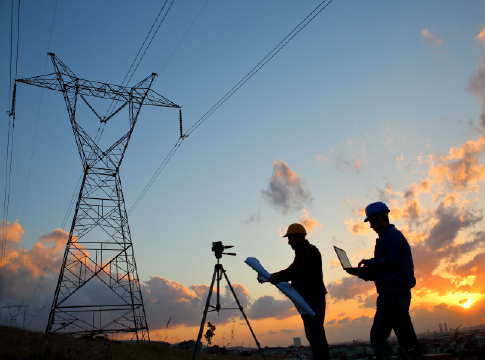Related News
Related News
-
Energy shortfall of 9 gigawatts projected for the Northwest
By 2030, a dry year combined with soaring energy demand during extended cold snaps could lead to rolling blackouts, a new study warns.
Find Out More -
Sustainability Snapshot - Celebrating Energy Efficiency Projects in the Community
Sustainability Snapshops highlight impactful projects completed by EWEB's Customer Solutions department, as a way to celebrate the meaningful work happening behind the scenes.
Find Out More -
EWEB secures $2.5 billion of reliable, affordable, carbon-free energy for customers
The new contract with EWEB’s largest energy supplier, the Bonneville Power Administration, forms the foundation of a diverse energy portfolio.
Find Out More -
Women in STEM: Meet the Hydro Project Engineer Building Habitat for Salmon
EWEB Engineer Associate Val Chang found her way to the McKenzie River from Los Angeles, inspired by heritage trips to the waters of Taiwan and key mentors along the way.
Find Out More -
Public Power Week Poster Contest Winners 2025
The results are in! View the winning posters from EWEB's 2025 Public Power Week Poster Contest.
Find Out More -
EWEB Hometown Heroes compete internationally
Out of 290 teams from 14 different countries, EWEB's Lineman Rodeo team places in the top third of competitors.
Find Out More -
Vote for your favorite Public Power Week Posters
The top five submittals will receive awards. Help us pick the winners.
Find Out More -
Electric Projects underway in North & South Eugene
Underground lines and disaster-resilient power poles are part of EWEB’s infrastructure upgrade near Eugene’s largest natural resource area.
Find Out More -
The Bonneville Power Administration Rate Change and Your EWEB Bill
BPA’s finalized rate increase is smaller than projected, and EWEB’s pass-through adjustment effective October 1, 2025 will now be 2.7% for residential customers—down from the anticipated 4%.
Find Out More -
EWEB completes helicopter installation of salmon habitat features
EWEB adds downed trees and 2,000 tons of gravel to the Uupper McKenzie River below Tamolitch Falls to improve spawning habitat.
Find Out More -
Court rules in favor of EWEB in Carmen-Smith litigation
The U.S. District Court in Eugene has granted EWEB's motion to dismiss a lawsuit brought under the Endangered Species Act pertaining to fish passage at EWEB’s Trail Bridge Dam. The favorable ruling clears the way for EWEB to continue advancing towards implementation of permanent fish passage at the dam.
Find Out More -
EWEB proposes modified plan for permanent fish passage at Trail Bridge Dam
After eight months of extensive collaboration and analysis with scientific experts at two federal regulatory agencies, EWEB is proposing an improved plan to build permanent fish passage facilities at Trail Bridge Dam on the McKenzie River.
Find Out More -
Sustainability Snapshot - Ideal Steel July 2025
Our second Sustainability Snapshop highlights a project where EWEB helped a local industrial warehouse upgrade over 1,000 flourescent lights to new efficient LEDs.
Find Out More -
EWEB prepares for wildfire season with risk mitigation measures
EWEB is building a more resilient electric system to weather various types of disasters, from wildfire to winter storms.
Find Out More -
EWEB, Lane County host open house to gather feedback for “Leaburg Transportation Alternatives Analysis”
“What is the Future of the Leaburg Dam Bridge?” open house exhibit on display at Lloyd Knox Park Visitor Pavilion through July 25
Find Out More - Show More
EWEB’s heat-driven call to conserve energy yields major savings
August 24, 2023 • Aaron Orlowski, EWEB Communications

By acting collectively and making small adjustments to temporarily reduce energy consumption, EWEB customers played a crucial role in maintaining grid stability during last week’s extreme heat wave.
Electricity was in short supply for several days last week as temperatures crested 100 degrees for four days in a row and several regional electricity generators were shut down due wildfire conditions, including EWEB’s Carmen-Smith hydroelectric project.
In response, EWEB issued its first-ever voluntary call for customers to safely conserve energy on Tuesday, Aug. 15, sending an email to 66,000 residential, commercial and industrial customers, and issuing an alert on social media.
Customers responded in force by raising the temperature settings on their air conditioners, charging electric vehicle overnight rather than in the evening, delaying running large appliances such as dryers or dishwashers until after 9 p.m. and turning off unnecessary lights and electronics.
By comparing customers’ hourly electricity demand on Monday, Tuesday and Wednesday, EWEB estimated that customers’ actions caused demand to be 10 to 15 megawatts lower than expected, given the temperatures and compounding heat effects. That’s roughly the equivalent of 10,000 to 15,000 window air conditioners getting shut off.
“The whole community came together in this time of duress to do something none of us could do on our own,” said EWEB Chief Energy Resources Officer Brian Booth. “The results show that if everyone makes a small individual effort, then we can have a huge collective impact.”
By paring back consumption, customers both reduced strain on the grid and contributed to keeping EWEB’s electric rates low by helping EWEB avoid paying exorbitant prices for electricity on the wholesale market. Power prices fluctuate by the hour, and customers’ actions allowed EWEB to skip purchasing some energy when prices were at their highest – ultimately saving EWEB customers money on rates in the long run.
On Tuesday and Wednesday, power prices ranged from $70 per megawatt-hour overnight, when demand was lowest, to as high as $1,800 per megawatt-hour from 5 to 8 p.m. when demand was highest. At the peak of the day, when prices were highest, reduced energy usage saved EWEB and customers approximately $10,000 per hour.
“As a publicly owned utility, every dollar we save is a dollar that our customer-owners ultimately don’t have to spend on rates. Instead, we’re able to keep rates low and continue to invest in community assets today that will keep us resilient tomorrow,” Booth said. “At the same time, when customers trim electricity demand when it’s at its highest, they reduce carbon emissions, since peak electricity tends to have higher carbon emissions.”
Call to conserve mirrors future demand response possibilities.
Future customer programs that EWEB will soon start assessing could look like last week’s call to conserve.
Electric utilities across the Northwest and the entire nation have instituted various “demand response” programs that incentivize customers to use less electricity when overall demand is at its highest.
Some programs connect the smart thermostats of customers who enroll to the utility’s systems, which can then cycle them on and off to reduce electricity consumption at peak times. Others similarly use smart electric vehicle chargers that the utility can cycle off during peak demand.
Still others use rates and pricing structures that incentivize customers to reduce their peak consumption on their own. Time-of-use rates, critical peak pricing and similar pricing schemes charge customers different amounts depending on when they use electricity. Others, such as peak-time rebates, compensate customers for scaling back consumption during peak periods.
All these programs largely depend on advanced metering infrastructure, or smart meters. EWEB has been rolling out smart meters to customers free of charge over the last several years, though supply chain disruptions in the last two years have slowed down deployment. So far, EWEB has deployed more than 68,000 electric smart meters, covering about 69% of customers.
Demand response programs also rely on modern back-end computer systems that better integrate information related to metering, energy supply, customer demand and billing. EWEB is currently undergoing a major technology upgrade to do just that.
“Demand response programs are one of the most promising methods we have to dynamically respond to wholesale electricity markets that are becoming more and more extreme and challenging,” Booth said. “As the Northwest adds more and more variable resources such as wind and solar to the grid, we need to better align demand with supply. Customers will play a key role in that.”
EWEB’s 2023 Integrated Resource Planning (IRP) process identified demand response programs as a key element of the utility’s future resource mix. The IRP forecasted electricity demand 20 years into the future and used modeling software to analyze dozens of resource options – such as wind, solar and hydropower – to create potential mixes of electricity sources that will reliably meet customers’ needs at the lowest price while being 95% carbon-free.
The analysis yielded valuable insights about the challenges EWEB faces in the future. EWEB doesn’t need to procure any resources in the next few years and will instead spend that time conducting additional analysis and preparing for the 2025 IRP.
One of those studies will look specifically at demand response. The study will seek to determine how much potential exists among EWEB customers for demand response programs, which ones are the best fit, how much they would cost to administer and what benefits would result. EWEB will also conduct a study on the potential to incentivize customers to conserve and consume less energy overall.
With climate change worsening, conditions like EWEB faced last week will only grow more common – and with that the need for flexible energy consumption.
“When evaluating customers’ response to last week’s request to conserve, I get excited about the value for participating customers if we had a formal demand response program,” Booth said. “If we could count on customers to provide that same response in the future when we experience extreme weather events, that same level of response represents many millions of dollars’ worth of battery storage, for example, that we potentially could avoid building.”
More Information
EWEB’s Integrated Resource Plan (IRP) will analyze possible energy resource portfolios with a goal of creating useful insights for long-term (20-year) electricity supply planning decisions.




